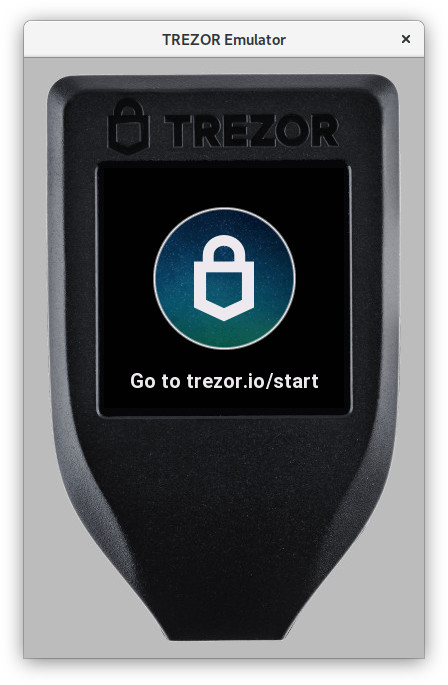Emulator
:bulb: Hint: Using emulator as described here is useful during firmware development. If you intend to use the emulator without modifying the firmware, you might be looking for Trezor User Env.
Emulator is a unix version of Core firmware that runs on your computer.

There is neither boardloader nor bootloader and no firmware uploads. Emulator runs the current code as is it is and if you want to run some specific firmware version you need to use git for that (simply checkout the right branch/tag). Actually, maybe we should call it simulator to be precise, because it does not emulate the device in its completeness, it just runs the firmware on your host.
Emulator significantly speeds up development and has several features to help you along the way.
⚠️ Disclaimer ⚠️
This emulator is for development purposes only. It uses a pseudo random number generator, and thus no guarantee on its entropy is made. No security or hardening efforts are made here. It is, and will continue to be, intended for development purposes only. Security and hardening efforts are only made available on physical Trezor hardware.
Any other usage of the emulator is discouraged. Doing so runs the risk of losing funds.
How to run
- build the emulator
- run
emu.pyinside theuvenvironment:- either activate the
uvenvironment first, and then use./emu.py - or always use
uv run ./emu.py
- either activate the
- start the bridge:
- to initialise the bridge with emulator support, start it with
trezord-go -e 21324 - alternatively, launch the desktop suite from the command line with the argument
--bridge-dev
- to initialise the bridge with emulator support, start it with
Now you can use the emulator the same way as you use the device, for example you can use Trezor Suite, use our Python CLI tool (trezorctl), etc. Simply click to emulate screen touches.
Features
Run ./emu.py --help to see all supported command line options and shortcuts. The
sections below only list long option names and most notable features.
Debug and production mode
By default the emulator runs in debug mode. Debuglink is available (on port 21325 by default), exceptions and log output goes to console. To indicate debug mode, there is a red square in the upper right corner of Trezor screen.

To enable production mode, run ./emu.py --production, or set environment variable PYOPT=1.
Initialize with mnemonic words
In debug mode, the emulator can be pre-configured with a mnemonic phrase.
To use a specific mnemonic phrase:
./emu.py --mnemonic "such deposit very security much theme..."
When using Shamir shares, repeat the --mnemonic option:
./emu.py --mnemonic "your first share" --mnemonic "your second share" ...
To use the "all all all" seed defined in SLIP-14:
./emu.py --slip0014
./emu.py -s
Storage and Profiles
Internal Trezor's storage is emulated and stored in the /var/tmp/trezor.flash file by
default. Deleting this file is similar to calling wipe device. You can also find
/var/tmp/trezor.sdcard for SD card. Starting the emulator with -e / --erase will
delete the files beforehand.
You can specify a different location for the storage and log files via the -p /
--profile option:
./emu.py -p foobar
This will create a profile directory in your home ~/.trezoremu/foobar containing
emulator run files. Alternatively you can set a full path like so:
./emu.py -p /var/tmp/foobar
You can also set a full profile path to TREZOR_PROFILE_DIR environment variable.
Specifying -t / --temporary-profile will start the emulator in a clean temporary
profile that will be erased when the emulator stops. This is useful, e.g., for tests.
Logging
By default, emulator output goes to stdout. When silenced with --quiet, it is
redirected to ${TREZOR_PROFILE_DIR}/trezor.log. You can specify an alternate output
file with --output.
Running subcommands with the emulator
In scripts, it is often necessary to start the emulator, run a command while it is available, and then stop it. The following command runs the device test suite using the emulator:
./emu.py --command pytest ../tests/device_tests
Profiling support
Run ./emu.py --profiling, or set environment variable TREZOR_PROFILING=1, to run the
emulator with a profiling wrapper that generates statistics of executed lines.
Memory statistics
Run ./emu.py --log-memory, or set environment variable TREZOR_LOG_MEMORY=1, to dump
memory usage information after each workflow task is finished.
Run in gdb
Running ./emu.py --debugger runs emulator inside gdb/lldb.
Watch for file changes
Running ./emu.py --watch watches for file changes and reloads the emulator if any
occur. Note that this does not do rebuild, i.e. this works for MicroPython code (which
is interpreted) but if you make C changes, you need to rebuild yourself.
Print screen
Press p on your keyboard to capture emulator's screen. You will find a png screenshot
in the src directory.
Disable animation
Run ./emu.py --disable-animation, or set environment variable
TREZOR_DISABLE_ANIMATION=1 to disable all animations.